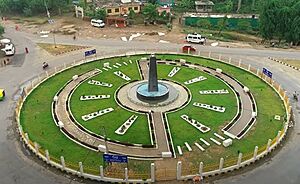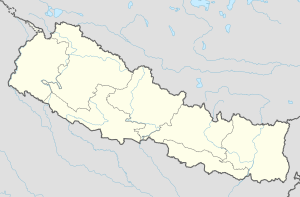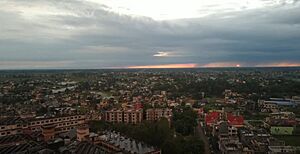Kohalpur facts for kids
Quick facts for kids
Kohalpur
कोह
Kolpur
|
|
|---|---|
| Kohalpur Municipality | |

Roundabout at Kohalpur Chowk (2019)
|
|
| Country | |
| Province | Lumbini |
| District | Banke |
| Area | |
| • Total | 685 km2 (264 sq mi) |
| Population
(2021)
|
|
| • Total | 100,289 |
| • Density | 146.41/km2 (379.19/sq mi) |
| Time zone | UTC+5:45 (NST) |
| Postal code |
21904
|
| Area code(s) | 081 |
| Website | www.kohalpurmun.gov.np |
Kohalpur (Nepali: कोहलपुर) is a growing city in Nepal. It is located in the Banke District of the Lumbini province. This city became a municipality on May 18, 2014. It was formed by joining two older areas called Rajhena and Kohalpur.
Kohalpur is on the main East-West highway. It is one of the fastest developing places in Nepal. The city of Nepalgunj is about 16 km (10 mi) to the south. The Indian border is only 6 km (4 mi) further south. Kohalpur is a major crossroads for roads going in all directions.
You can reach Kohalpur by air through Nepalgunj Airport. It is also accessible by road, about 535 km (332 mi) west of Kathmandu, Nepal's capital.
Contents
Becoming a Municipality
Kohalpur is the second municipality in the Banke District. The first one is Nepalgunj. Being a municipality means Kohalpur has more control over its local government. It also gets more money from the central government. This helps promote local power and development.
Kohalpur was officially declared a municipality in 2018. Before that, its status was delayed several times.
How Kohalpur is Governed
Kohalpur is part of the Banke District. The district is managed by a Local Development Officer. Even though Kohalpur is a municipality, it used to be a Village Development Committee (VDC). A VDC had 9 smaller areas called wards. Each ward had a group called a Ward Citizen Forum (WCF). These forums helped manage things at the community level.
For a while, a government-appointed secretary managed the VDC. Big city development projects in the district had to be approved by the District Council. Local groups, called CBOs, also played a big role. They worked with the VDC and other groups to carry out local projects.
There are also Town Development Committees (TDCs) in Nepal. TDCs help organize people locally. They create partnerships between the community and the government. This helps improve services like education and health. TDCs have some control over development. They also make sure government money is used well.
Where Kohalpur is Located
Kohalpur is in the Banke District. This area is in the Mid-West Region of Nepal, known as the Terai region. The total area of Kohalpur is about 2,816.6 hectares (6,960 acres).
The weather in Kohalpur is subtropical. Temperatures can go from a high of 46 °C (115 °F) to a low of -2 °C (28 °F).
Nature and Environment
Kohalpur has a large forest area of about 1,025.1 hectares (2,533 acres). This forest connects to the Bardia National Park. Sadly, this forest is shrinking due to deforestation. For example, 16.20 hectares (40.0 acres) were cut down in 2010.
A lot of land in Kohalpur is used for farming. About 1,452.8 hectares (3,590 acres) are farmable land. About 91% of this land is actively used for agriculture.
The Dudhuwa River flows through part of Kohalpur. Areas near this river are sometimes affected by flooding. About 185.8 hectares (459 acres) of the area can be flooded.
A big project called the Sikta Irrigation Project is now starting. It will bring water from the Rapti River. This project is expected to help many farmers in the area. It is a very important project for Nepal.
People of Kohalpur
In 2021, Kohalpur Municipality had a population of 100,289 people.
According to the 2011 Nepal census, Kohalpur had 72,748 people. Most people (65.3%) spoke Nepali. Other languages spoken included Tharu (24.0%) and Awadhi (5.0%).
Many different ethnic groups live in Kohalpur. The largest groups include Tharu (24.7%), Chhetri (20.4%), and Hill Brahmin (15.8%).
Most people in Kohalpur follow Hinduism (93.2%). Other religions include Muslim (3.0%), Christian (2.4%), and Buddhist (1.4%).
Economy and Jobs
Most people in Kohalpur work in farming and raising animals (52.88%). Other jobs include day labor (21.90%), business (11.27%), and working for the government or other organizations (13.86%). A very small number of people work in small industries (0.09%).
Education in Kohalpur
Kohalpur has a good number of educated people. The municipality has three college campuses. It also has six higher secondary schools (grades 10-12), four lower secondary schools (grades 1-7), and 12 primary schools (grades 1-5).
The Medical College in Kohalpur is a very important education center. Students come from all over Nepal, and even from India and Sri Lanka, to study there.
Here are some of the schools and colleges in Kohalpur:
- Tribhuwan Higher Secondary School
- Jeevan Jyoti Higher Secondary School
- Bridge International School
- Green Peace Secondary School
- Bageshwari Academy
- Shri Ram Janaki Higher Secondary School
- Gorkha United Public School
- Takshashila Academy Banke
- Noble English Medium Secondary School
- Kohalpur Model College (KMC)
- Gyan Jyoti Secondary School, Chappargaudi
- Baljyoti Secondary School, NTV road
City Services
Kohalpur has several health facilities. These include the Medical College, one Health Post, one Sub-Health Post, and 13 private medical centers.
Basic services like garbage collection are still developing. There is no official system for managing solid waste yet. These services need to be improved for everyone in Kohalpur.
For water, about 68% of homes have water pipelines. Another 31.15% use hand pumps to get underground water. The rest use other sources.
When it comes to toilets, out of 4,735 homes, 1,548 do not have one. Many homes use septic tanks (2,046 homes). Some use temporary toilets (841 homes) or biogas toilets (131 homes).
Most homes (87%) in Kohalpur have electricity from the central power line. The remaining 13% use kerosene for light. Some homes also use clean energy sources like solar panels and biogas.
Media and News
To share local culture and news, Kohalpur has two F.M. Radio Stations:
- Pratibodh F.M. - 102.4 MHz
- Radio Kohalpur - 101.2 MHz
Many local and national newspapers are also available. These include Kantipur and The Kathmandu Post.
For television, there are three cable operators:
- Bageshwari Cable Pvt. Ltd
- Super Vision Cable Pvt. Ltd
- Madhyapaschim Cable Pvt. Ltd
Kohalpur Television, a local version of Nepal Television, also restarted broadcasting in 2073 (Nepali calendar year).





